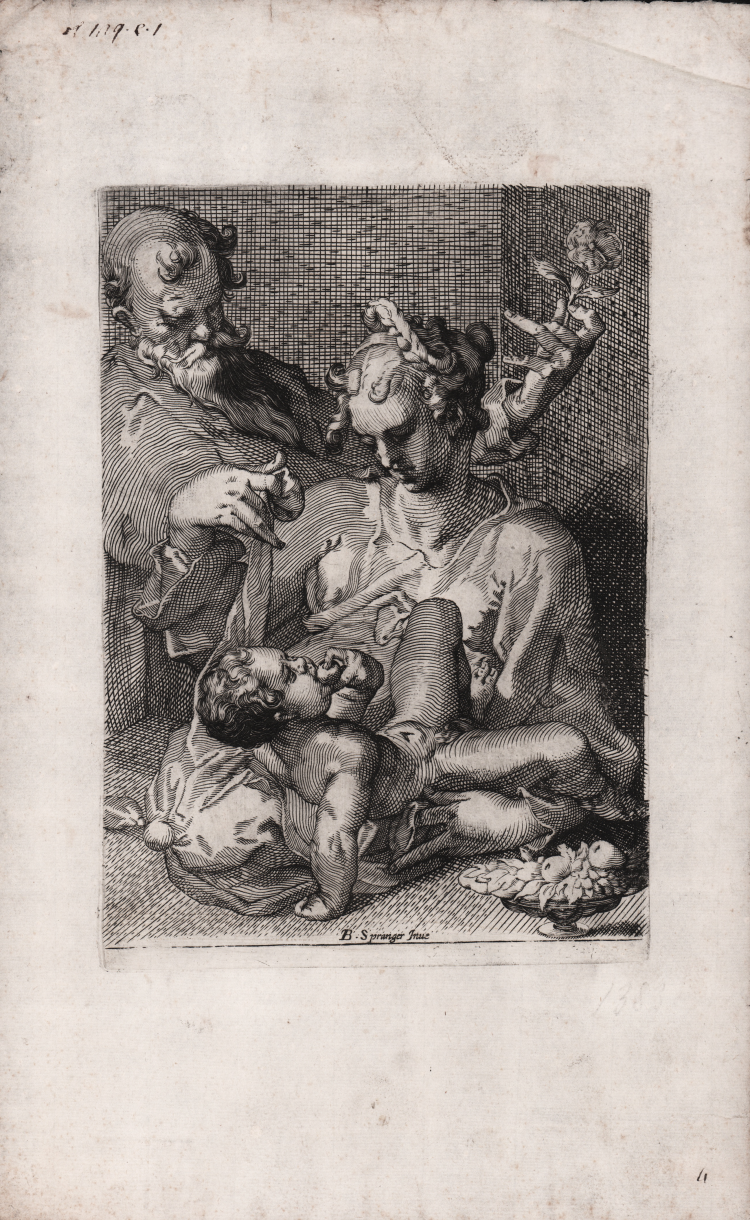



| Reference: | S45135 |
| Author | Bartholomäus Spranger |
| Year: | 1590 ca. |
| Measures: | 160 x 230 mm |


| Reference: | S45135 |
| Author | Bartholomäus Spranger |
| Year: | 1590 ca. |
| Measures: | 160 x 230 mm |
Engraving, circa 1590, letter at the bottom B. Spranger Inve.
After Bartolomeus Spranger.
A fine, early, impression printed with tone on contemporary laid paper without watermark, with large margins, , traces of glue in the verso of the top, otherwise very good condition.
A very rare work. An example, trimmed inside of the copperplate and lacking the lower white part, below the inscription, was recently sold at Swann Galleries auction in New York:
Bibliografia
Bartsch 297, copy.
Bartholomäus Spranger (Anversa, 1546 – Praga, 1611)
|
Bartholomäus Spranger (Antwerp, 1546 - Prague, 1611) was a Flemish painter and engraver. A master who in himself summed up all the trends of European Neo-Mannerism, Spranger vividly characterized the artistic season of the Habsburg court under Rudolph II, emperor of the Holy Roman Empire, who moved the capital of his kingdom from Vienna to Prague, giving rise to a period of sumptuous collecting (the wunderkammern) and sophisticated patronage. Trained in Antwerp, a city already at the time influenced by a mid-Renaissance Italianate style, he was a disciple of Jan Mandyn and Cornelis van Dalem. In 1565 he set out for Italy, residing mainly in Milan, where he absorbed the up-to-date stimuli of Lombard art, and Parma, studying painters such as Correggio and Parmigianino and absorbing their style, and for France; here he attended the Mannerist school of Fontainebleau, thus definitively directing his style, precisely, toward Mannerism. He lived for a time in Rome, working for large patrons such as the Farnese family at Caprarola, immersing himself in the most refined Roman Mannerism, so much so that he was appointed papal painter in 1570. He then worked, thanks to a warm recommendation from Giambologna, as court painter in Vienna and then in Prague for Rudolph II of Habsburg between 1575 and 1611, working in the same years with the Milanese Giuseppe Arcimboldi, the Germans Joseph Heintz the Elder and Hans von Aachen, as well as Milanese masters and intaglio and goldsmithing. The works most prized by the emperor are those in which Spranger, under the guise of depicting classical myths, stages ample and luminous female nudes to satisfy his savory and fleshy desire. Popularized through engravings, these paintings became known in various European nations, thus contributing to the spread of Mannerist art in Europe. Spranger did not produce many sacred-themed paintings, always preferring the mythological and literary realm. In depicting these allegorical subjects Spranger expressed himself in a language steeped in Italian culture, but at the same time he succeeded in conveying a kind of cold sensuality that was all the more provocative than seemingly detached. He thus created a personal style of intelligent refinement that, at the time, brought intellectuals closer to the new European art. His highly elaborate and sustained Mannerism is considered one of the best outside Italy.
|
Bartholomäus Spranger (Anversa, 1546 – Praga, 1611)
|
Bartholomäus Spranger (Antwerp, 1546 - Prague, 1611) was a Flemish painter and engraver. A master who in himself summed up all the trends of European Neo-Mannerism, Spranger vividly characterized the artistic season of the Habsburg court under Rudolph II, emperor of the Holy Roman Empire, who moved the capital of his kingdom from Vienna to Prague, giving rise to a period of sumptuous collecting (the wunderkammern) and sophisticated patronage. Trained in Antwerp, a city already at the time influenced by a mid-Renaissance Italianate style, he was a disciple of Jan Mandyn and Cornelis van Dalem. In 1565 he set out for Italy, residing mainly in Milan, where he absorbed the up-to-date stimuli of Lombard art, and Parma, studying painters such as Correggio and Parmigianino and absorbing their style, and for France; here he attended the Mannerist school of Fontainebleau, thus definitively directing his style, precisely, toward Mannerism. He lived for a time in Rome, working for large patrons such as the Farnese family at Caprarola, immersing himself in the most refined Roman Mannerism, so much so that he was appointed papal painter in 1570. He then worked, thanks to a warm recommendation from Giambologna, as court painter in Vienna and then in Prague for Rudolph II of Habsburg between 1575 and 1611, working in the same years with the Milanese Giuseppe Arcimboldi, the Germans Joseph Heintz the Elder and Hans von Aachen, as well as Milanese masters and intaglio and goldsmithing. The works most prized by the emperor are those in which Spranger, under the guise of depicting classical myths, stages ample and luminous female nudes to satisfy his savory and fleshy desire. Popularized through engravings, these paintings became known in various European nations, thus contributing to the spread of Mannerist art in Europe. Spranger did not produce many sacred-themed paintings, always preferring the mythological and literary realm. In depicting these allegorical subjects Spranger expressed himself in a language steeped in Italian culture, but at the same time he succeeded in conveying a kind of cold sensuality that was all the more provocative than seemingly detached. He thus created a personal style of intelligent refinement that, at the time, brought intellectuals closer to the new European art. His highly elaborate and sustained Mannerism is considered one of the best outside Italy.
|